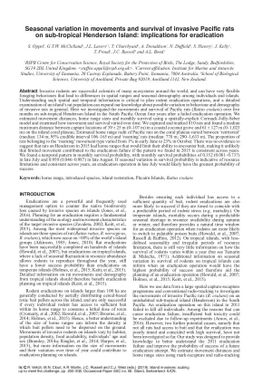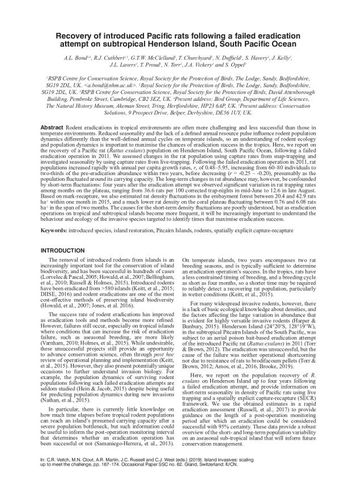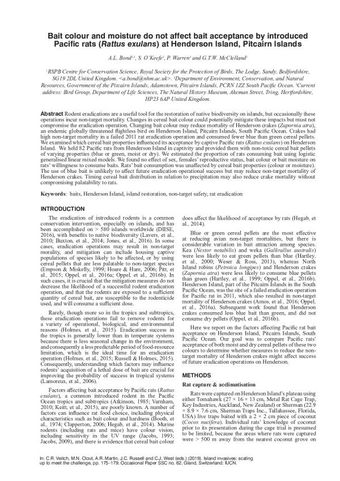Seasonal variation in movements and survival of invasive Pacific rats on sub-tropical Henderson Island: implications for eradication.
- Description:
- Invasive rodents are successful colonists of many ecosystems around the world, and can have very flexible foraging behaviours that lead to differences in spatial ranges and seasonal demography among individuals and islands. Understanding such spatial and temporal information is critical to plan rodent eradication operations, and a detailed examination of an islands rat population can expand our knowledge about possible variation in behaviour and demography of invasive rats in general. Here we investigated the movements and survival of Pacific rats (Rattus exulans) over five months on sub-tropical Henderson Island in the South Pacific Ocean four years after a failed eradication operation. We estimated movement distances, home range sizes and monthly survival using a spatially-explicit Cormack-Jolly-Seber model and examined how movement and survival varied over time. We captured and marked 810 rats and found a median maximum distance between capture locations of 39 ± 25 m (0107 m) in a coastal coconut grove and 61 ± 127 m (01,023 m) on the inland coral plateau. Estimated home range radii of Pacific rats on the coral plateau varied between territorial (median: 134 m; 95% credible interval 106165 m) and roaming rats (median: 778 m; 2901,633 m). The proportion of rats belonging to the roaming movement type varied from 1% in early June to 23% in October. There was no evidence to suggest that rats on Henderson in 2015 had home ranges that would limit their ability to encounter bait, making it unlikely that limited movement contributed to the eradication failure if the pattern we found in 2015 is consistent across years. We found a temporal pattern in monthly survival probability, with monthly survival probabilities of 0.352 (0.0810.737) in late July and 0.950 (0.8460.987) in late August. If seasonal variation in survival probability is indicative of resource limitations and consistent across years, an eradication operation in late July would likely have the greatest probability of success.
- Display date:
- 2019
- Collections:
- Secretariat of the Pacific Regional Environment Programme (SPREP)
- Publisher:
- Secretariat of the Pacific Regional Environment Programme (SPREP)
- Content partner:
- Secretariat of the Pacific Regional Environment Programme (SPREP)
- Availability:
- Not specified
-
Copyright status: All rights reservedFind out more about what you are able to do with this itemThis item is all rights reserved, with means you'll have to get permission from Secretariat of the Pacific Regional Environment Programme (SPREP) before using it. For more information, please see our use and reuse page.What can I do with this item?Non-infringing useNZ copyright law does not prevent every use of a copyright work, and this item may be hosted by an international institute or organisation. You should consider what you can and cannot do with a copyright work.No sharingYou may not copy and/or share this item with others without further permission. This includes posting it on your blog, using it in a presentation, or any other public use.No modifyingYou are not allowed to adapt or remix this item into any other works.No commercial useYou may not use this item commercially.
Related items
Welcome and warm Pasifik greetings
The information on this site has been gathered from our content partners.
The names, terms, and labels that we present on the site may contain images or voices of deceased persons and may also reflect the bias, norms, and perspective of the period of time in which they were created. We accept that these may not be appropriate today.
If you have any concerns or questions about an item, please contact us.


